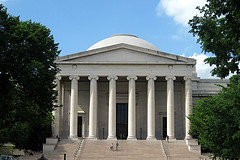Private philanthropy is an American tradition. Out country is full of public buildings gifted by successful individuals who believe that their success comes from the American system and the strength and independence of its people.
One example treated to a whole chapter in Amity Shlaes book on the great depression, The Forgotten Man. Andrew Mellon was an incredibly successful man who not only created great wealth. He also served in the administrations of three Presidents. Because of his success, he was a target of the Roosevelt government for tax evasion. This while he was planning his gift of a fabulous art collection and a new building to house it to the American people.
He eventually defended himself in the tax case and gave the people of the United States what is now the National Gallery.
In his mind, he was demonstrating that private citizens could be better stewards that the government if freed from unreasonable taxes and constraints at the same time Roosevelt was trying to strip wealth from the people who created it.
“But what was new was something that Mellon was only now revealing– what had been on his mind all these years, the philosophy behind the donations of the collection. Mellon was not trying to bribe the government, or even placate it. He was trying to outclass it.”
This new art museum in Arkansas is a demonstration that this spirit in American entrepreneurs is still strong. The Crystal Bridges Art Museum in Bentonville Arkansas is being built to house the collection of American art collected by Alice Walton. America would be a much poorer place if Roosevelt had succeeded in striping the wealth away from successful people. This collection and this museum would never exist if we depended on the government to create it.
Related articles by Zemanta
- Crystal Bridges Museum of American Art in Arkansas Names a New Director (nytimes.com)


Ralph, thanks for the kind words. This is an interesting post. I do not think that it is “blogfaking” (boy, I hope the x-faking terminology takes off) This post is informational. Your concern likely (and rightly) stems from the fact that while the post is full of information, it’s not full of actionable information.
Yes, the example of the art museum is a bit motivating to consider donation, but maybe provide an avenue to donate or reasons to donate to a specific fund, etc. Something that the reader can use beyond reading this page.
I posted a photoshoot on my website today, which you might think can’t provide anything for the reader to do. Far from it, since I used a novel, accessible design method (chalk), the reader can immediately think of how to implement their own designs. I’ll follow up on that by discussing techniques tomorrow.
Consider, with each post, whether your reader will be able to take away something that they can apply to their lives, or whether you provide an action that you think will give value to the reader.
Keep going.
Barry